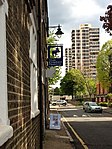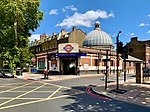Lorrimore Square
Squares in the London Borough of Southwark

Lorrimore Square is a 1.5-acre (0.6 ha) garden square in the far south-west of Southwark, London, England, centred 500 metres south-east of Kennington tube station. It is divided into four sections, a church with integrated drop-in centre; a small enclosed garden without paths; a public playground/gardens; and a basketball/netball pitch. One side of the square is classical architecture of four storeys, the other two sides — the fourth side marks the end of units on another road — are late 20th century rows of apartments of slightly lower height.
Excerpt from the Wikipedia article Lorrimore Square (License: CC BY-SA 3.0, Authors, Images).Lorrimore Square
Lorrimore Square, London Elephant and Castle (London Borough of Southwark)
Geographical coordinates (GPS) Address Nearby Places Show on map
Geographical coordinates (GPS)
| Latitude | Longitude |
|---|---|
| N 51.484722222222 ° | E -0.10111111111111 ° |
Address
St. Paul's, Lorrimore Square
Lorrimore Square
SE17 3QT London, Elephant and Castle (London Borough of Southwark)
England, United Kingdom
Open on Google Maps










